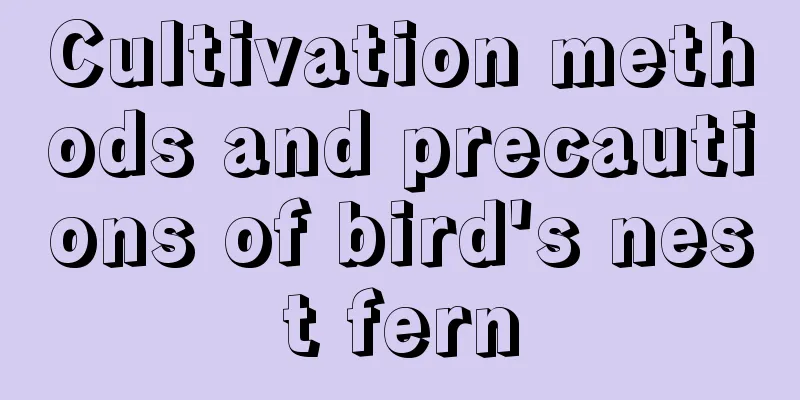Cultivation methods and precautions of bird's nest fern

|
Bird's nest fern , also known as nest fern, is a perennial herbaceous foliage plant with shiny green leaves all year round and high ornamental value. Here are some tips on growing bird's nest ferns. 1. Soil Bird's nest fern likes loose, breathable and well-drained soil. It can be planted evenly in peat soil or a mixture of coconut coir and perlite in a ratio of 2:1. You can choose a ceramic pot with good air permeability or a hanging coconut palm pot for the flower pot. After planting, water it thoroughly and place it in a cool and ventilated place for maintenance. 2. Lighting The native environment of the bird's nest fern is the understory of the tropical rainforest, where it can grow normally in scattered light. When caring for it indoors, place it in a bright place. Outdoors, you can also place it under the shade of a tree. Do not expose it to direct sunlight, as long-term exposure will burn the leaves. 3. Temperature Bird's nest fern likes a warm and humid environment. The suitable growth temperature is 16 to 27℃. It cannot be lower than 5℃ in winter. If the temperature is lower than 5℃ for a long time, it will suffer frostbite and die. When the temperature is above 30℃ in summer, provide shade and spray water to cool down. 4. Moisture The bird's nest fern has a high demand for water and must not be short of water, otherwise the leaves will easily turn yellow. Wait until the surface of the potting soil is dry and you can water it directly. When the temperature is usually high or humid, you need to spray the area around the plants frequently to increase the humidity, which helps keep the leaves green. After watering and spraying, pay attention to ventilation of the maintenance environment, otherwise anthracnose is likely to occur. 5. Fertilization The bird's nest fern does not have a high demand for nutrients and does not require frequent fertilization. Generally, you can use some liquid fertilizer during the growth period. It does not matter if you apply it once every half a month or twenty days. Usually, avoid using high-concentration fertilizers to avoid burning the seedlings. If you find that the bottom leaves are turning yellow during the maintenance process, don't worry. Yellowing of the bottom is normal. Cut off the yellow leaves in time and pay attention to the maintenance environment mentioned above. New leaves will soon grow from the middle. 6. Notes When the bird's nest fern grows to maturity, it will grow sub-plants (side branches) next to the mother plant. When the sub-plants grow a little bigger, they can be separated. The separated sub-plants should be placed in a ventilated and shaded place, and should be kept moisturized and ventilated, maintaining a high air humidity. Only after it grows new leaves can normal maintenance be resumed. That’s it |
<<: What is the planting season for Polygonatum sibiricum?
>>: When is the best time to plant tomatoes?
Recommend
How much does longan cost per pound?
1. Price It is one of the most popular fruits, us...
How to breed Rhododendron edulis
1. Watering method Rhododendron needs a lot of wa...
When is the best season to plant sugar apple?
Custard Apple Planting Season and Time The origin...
How long does it take for corn to germinate in summer?
Summer corn germination time The temperature is s...
When are oranges ripe for picking?
It is very important for growers to know when ora...
How to take cuttings of Dieffenbachia
1. Time Selection Generally, it is most suitable ...
These varieties of Clivia are very expensive for the pots, and you can’t even afford a leaf!
Clivia worth 8,000 yuan The Clivia in the picture...
How to propagate spring grass
Reproduction method Propagation by division Gentl...
How to propagate onions
Onion Planting Method This method only requires c...
What is the reason why spider plants turn yellow and what should I do if they wilt?
1. Reasons 1. Too much fertilizer: If you apply t...
Causes and treatments of yellow leaves of cactus
1. Soil compaction 1. Reason: If heavy, poorly dr...
Do cucumbers need watering every day?
Do you water cucumbers every day? Cucumbers can g...
How to plant white peony
Ecological environment White peony is also called...
Can woodruff be planted in the yard?
Can I plant wood fragrance flowers in the yard? T...
Diseases and Pests of Trachelospermum variegatedum and Their Control
Diseases and their control of Trachelospermum var...









